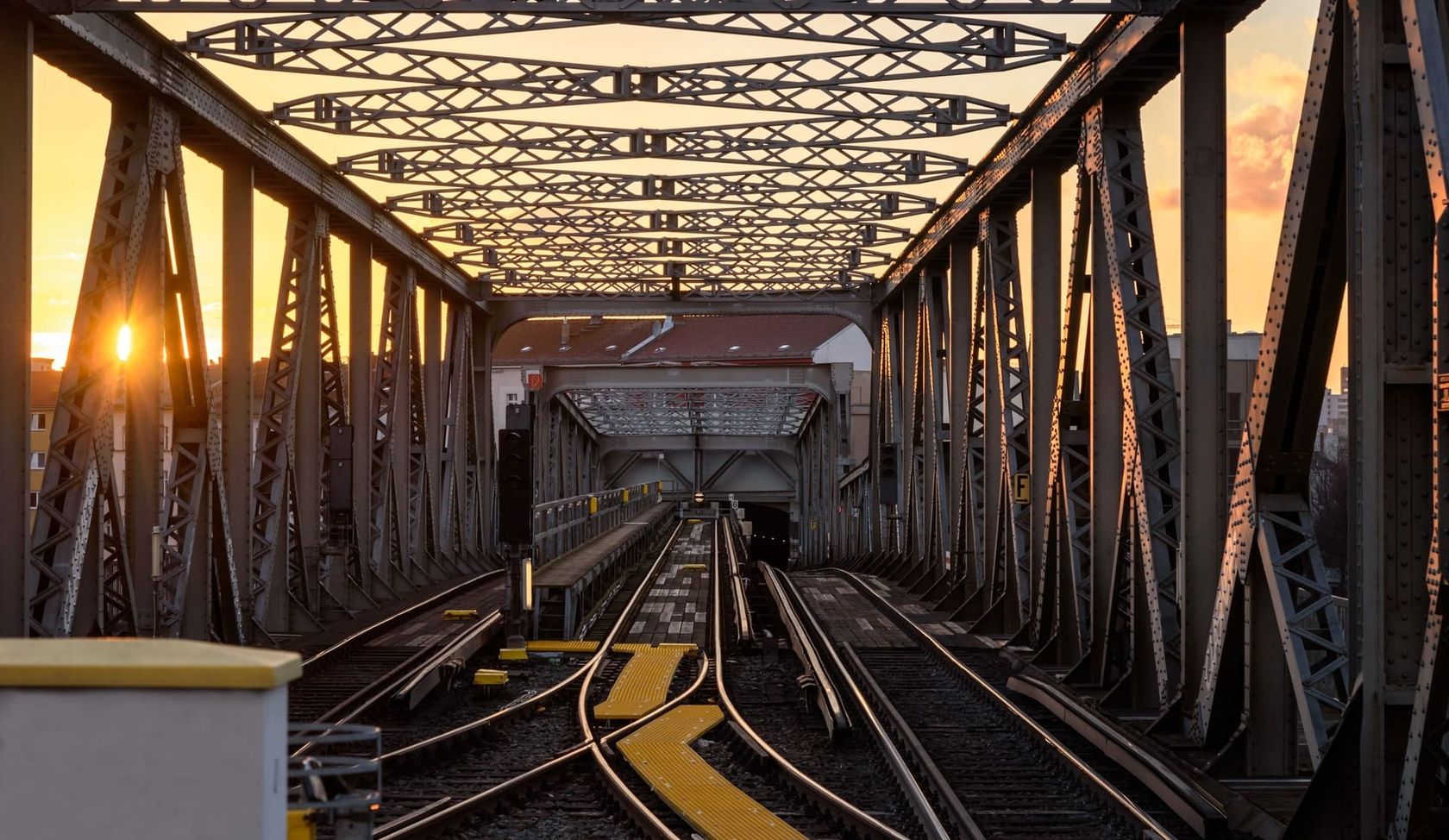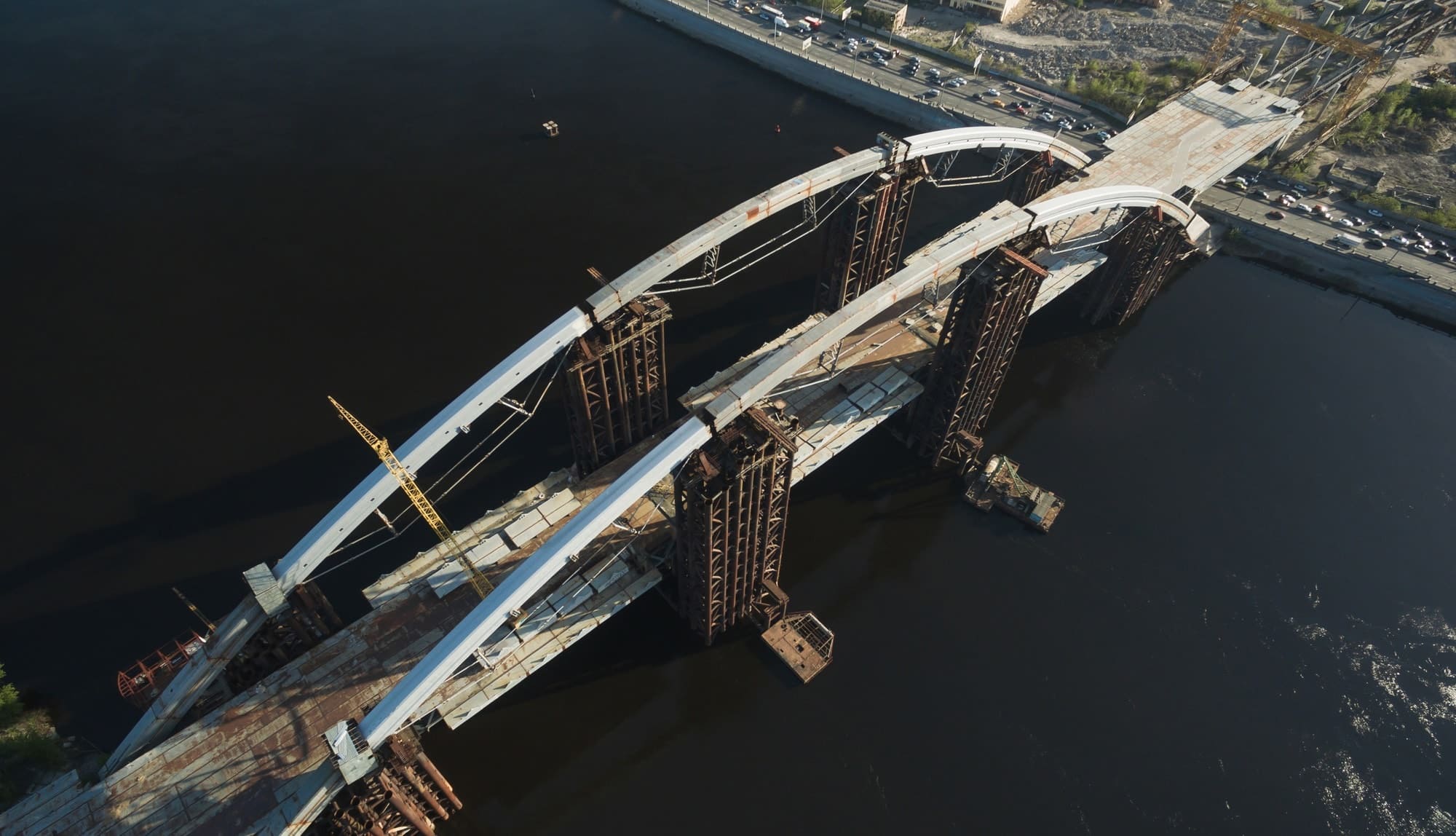It has been like this for a long time. Hundreds of years ago, as trade and militaries (which require quick redeployment of forces, arms, and supplies) evolved, they stimulated bridge construction. For a long time, bridges were made of wood and stone. Nowadays, rolled steel is the go-to material for bridge construction.
When and why did they begin to build steel bridges?
The more complex the transportation infrastructure and the more intense the freight and passenger traffic, the bigger the need for bridges and flyovers for the movement of vehicles, trains, and pedestrians. Structures built 50 to 70 years ago cannot cope with the modern load. This doesn’t just happen in Ukraine but also in other countries around the world. Traffic jams have become a daily routine in big cities, especially those divided by water. Now and then, we hear about the failures of old infrastructure. As a result, the demand for engineering work to renovate transport infrastructure grows every day. Modern bridge construction is impossible without steel. It is the main structural material in small, regional and large-scale national projects.
The cast-iron bridge that crosses the River Severn in the UK is considered the world's first iron bridge. It was opened in 1781. The chosen material did not prove to be very durable. The first cracks appeared in the cast iron in 1784. The brittle material was never widely used for this application.
Wood and stone continued to be the primary building materials for bridges for many years. It wasn’t until the 19th century that steel became the main material for bridge construction, due to technological advances in the steel industry. The widespread use of rolled steel for bridge construction began in parallel with the intensive development of railways. Wooden structures could not cope with loads and vibrations coming from heavy locomotives with wagons.
How many bridges does Ukraine need?
One hundred fifty years ago, there were only a few dozen bridges built using steel; today there are more than 16,000 bridges and flyovers in Ukraine alone. Practically all of them have steel structures or components. However, 80% of them were built before 1980. Virtually no one knows the real condition of these 50 to 60-year-old structures, because only 35% of them have been inspected, according to Urkavtodor, the country’s national roads agency. Of those, 12.6% are in good or partially good order. Around 58% are in serviceable condition. The rest of them, almost one-third of the inspected structures, are either completely unfit for service or in restricted operation.
And it does not end here. Of the inspected bridges, 64% do not meet current requirements (dimensions, load-carrying capacity, etc.). This means that this sector of Ukraine's transport infrastructure is in bad need of renovation. Only revamps and repairs have been mentioned so far, but it should be borne in mind that there is still a need to build new bridges, especially across the Dnipro and other big rivers.

As such, the Big Bridges Programme, with a total investment of around US$3 billion over the next five years, was announced in Ukraine in late May 2020. This is an ideal scenario, though. For now, Ukravtodor is ready to focus on the restoration and upkeep of 1,385 highway structures. The budget is UAH 28.7 billion. According to calculations, 90% of the required materials for this program can be produced in Ukraine, and specifically by our steelmakers, which have vast experience producing steel for bridges.
What are bridges in Ukraine and around the world built of?
Nowadays, steel is the main structural material used in bridge construction, since these engineering structures are built of structural steel and reinforced concrete.
There are several types of metal/steel bridges, which, except for their foundations, are built of steel structures:
- arch bridges
- slant-legged frame viaducts
- suspension and cable-stayed bridges with steel towers
- flyovers with steel supports
Steel bridges also include support bridges with steel superstructures.
Such bridges are made of steel structures, which are manufactured by specialist fabricators and assembled on-site.
Reinforced concrete bridges are a cheaper alternative to steel ones, but they require more time to build. Based on their design features, they are divided into three types:
- cast-in-situ
- precast
- precast and cast-in-situ
In this case, they use steel rebar of different diameter, over which concrete is poured.
Advantages of steel over reinforced concrete in bridge construction
Steel bridges have a number of advantages over reinforced concrete ones. First of all, it is the ability to carry out the fast fabrication of typical structures. The erection of such structures is fast-paced, no matter what time of year it is.
The weight of sub-assemblies is relatively low. For this reason, different erection techniques can be used, from the use of jib cranes for small regional bridges to bridge launching. This method was used for the erection of spans of the Shulyavskiy flyover in Kyiv.
The high strength and load-carrying capacity of steel, coupled with its light weight, allows the covering of large spans, which is especially important for wide roads and in cases where it is impossible to install additional supports in riverbeds.
It is relatively easy to repair or reinforce a damaged steel structure in the course of its operation.
The main drawback is the price that is influenced by the cost of flat-rolled steel used in the manufacture of steel structures and for corrosion protection.
As such, reinforced concrete is preferred in road construction, when it comes to large-scale design and construction of interchanges and small flyovers. In doing so, builders make substantial savings, while steel producers still get orders for rebar, which are used for trestles or reinforcement cages, over which concrete is poured.
What kind of steel is used for bridge structures?
Steel structures for bridges are primarily fabricated from steel plates. To manufacture individual components, coils, sections and shapes as well as electric-welded pipes can be used. Flat-rolled steel is cut, bent and welded by structural steel fabricators or machine builders that have the appropriate equipment. Steel alloys such as rolled steel must withstand high tension, compression, and torsional loads. A relatively lightweight finished structure must have high strength, corrosion resistance and durability.

Depending on the type of structure, different steel grades can be used in bridge construction. However, rolled products, which are used, are produced from killed (SP) and semi-killed (PS) steel as well as low-alloy steel.
Low-carbon steel 16D (equivalent– M16S), low-alloy rolled steel 14G2AFD and 15G2AFDt (both except for in railway bridges), and nickel and chromium alloys 15XSND and 10ХSND, produced according to the CIS standard, are used for superstructures with welded joints. Rolled structural components of strength classes S235 — S890, manufactured according to EN 10025 and its Ukrainian equivalent DSTU EN 10025 and supplied in the as-hot-rolled, normalised rolled, thermo-mechanically rolled, normalised, and quenched and tempered conditions are also widely used.
If load-carrying structures do not have welded joints, then the list of steel grades that can be used in bridge construction becomes significantly longer.
It should be pointed out that so-called Corten steel and its equivalent can also be used in bridge construction. Rolled products made from this weathering steel develop rust that does not cause damage; on the contrary, it provides self-protection. This protective layer (patina) develops on the surface of the steel over time, preventing destruction from the inside. This ensures savings during operation: one does not have to care about painting or protecting the structure against corrosion. The visual appearance is an additional benefit. Ukraine's only certified producer of weathering flat-rolled steel products according to EN 10025-5 is Metinvest Group, which manufactures these products at Azovstal, Ilyich Iron and Steel Works and at its European mills.
Ukravtodor's plans for the next five years are impressive. But how realistic are they? Players in the road-construction market admit that bridges are the most difficult sector of the country's infrastructure.
For this reason, foreign contractors are involved in large, landmark projects. For example, the construction of the bridge that crosses the Dnipro in Zaporizhia will be completed by a Turkish contractor. However, most of the steel structures and rolled-steel products for the project will be supplied by Ukrainian steelmakers. Around 14,000 tonnes of rolled steel will be required to complete the construction of this bridge. Metinvest-SMC already shipped 1,500tonnes of steel products in June. The construction of this giant bridge began in 2004. It is expected to be put into operation in the next two years. In parallel, the potential is being looked into to build several new bridges across the Dnipro in addition to the bridge in Zaporizhia and the Podolsko-Voskresenskiy Bridge crossing in Kyiv that is in its final stage of construction.
Some recent projects worth mentioning include the fundamental reconstructions of several flyovers in Kiev. The best known of them is the so-called Shuliavka Bridge. The steel spans of the bridge were completely replaced within one year. A 210-metre-long pedestrian bridge, connecting the Volodymyrska Hirka park and the Friendship of Nations Arch, was built from scratch and is now one of the landmarks of Ukraine's capital city. Steel structures for them were manufactured by one of the ship-building companies in Mykolaiv. Steel for bridge structures was produced by Ukrainian steelworks.
The restoration of the road infrastructure of Ukrainian Donbas is worth a separate mention. Several important bridges were destroyed as a result of military operations in the Donetsk and the Luhansk regions during 2014-2015. One of them was blown up in Mariupol in December 2014, practically cutting off the city from train service. Metinvest Group's enterprises located in Mariupol were on the brink of a shutdown. It took less than one year to rebuild the bridge with the direct involvement of steelmakers, and rail traffic to the capital city of Southeastern Ukraine, located on the shores of the Azov sea, is now back to normal.
The new bridge played an important role in Ukraine's steel industry. As such, it is symbolic that Ukrainian steel is now used for bridge construction not only in our country. In July, a new bridge was opened in Genoa, Italy. Metinvest Group supplied 18,500tonnes of rolled steel produced in Mariupol and Italy for this bridge.
